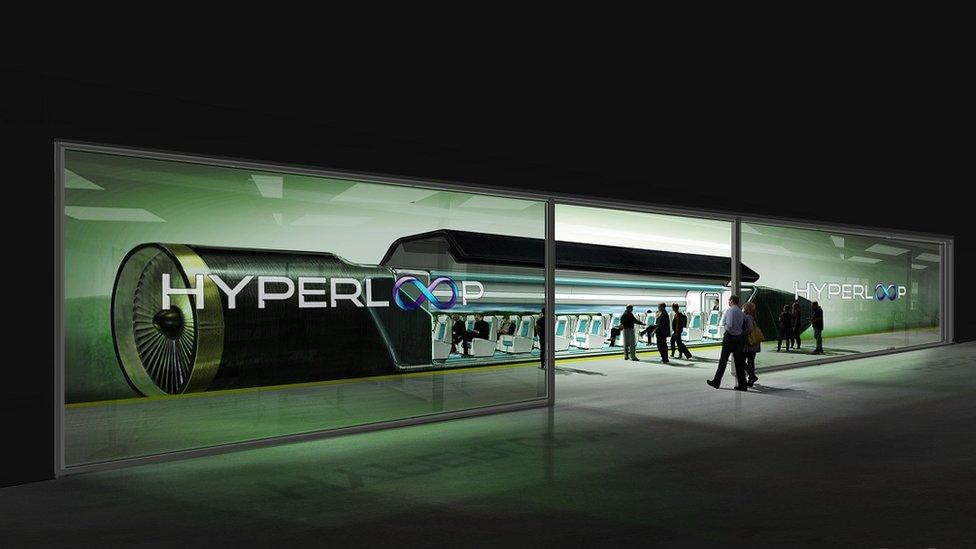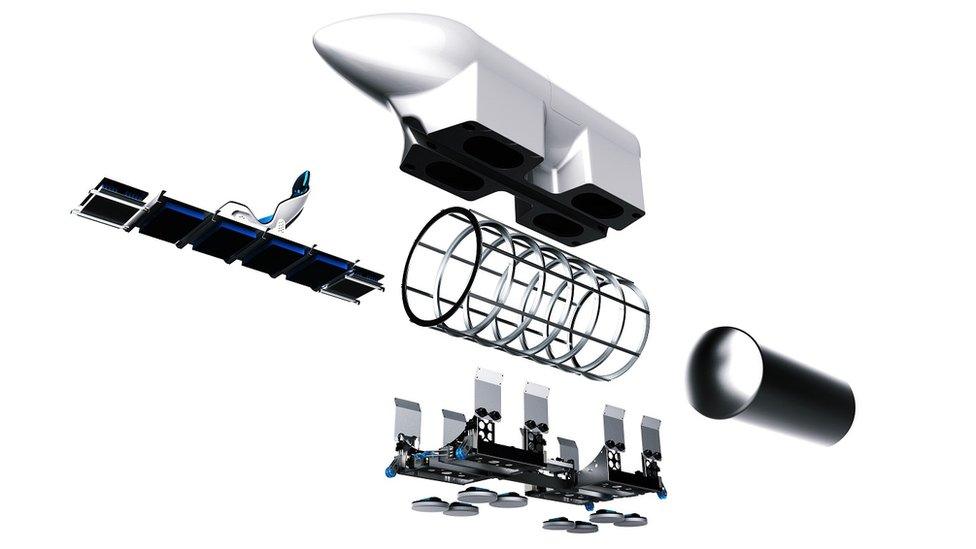The tech helping us work together wherever we are
- Published

Cloud computing is enabling people to work together despite being thousands of miles apart
Imagine working for a company staffed by people you never meet in person.
This is the new type of organisation cloud computing is helping to create - amorphous, geographically spread and collaborative.
Take rLoop, external, for example - a design collective aiming to develop pods for the futuristic high-speed transport concept called the Hyperloop.
The non-profit team comprises 400 people, but only nine have physically met.
Their story began in June 2015, when PayPal, SpaceX and Tesla entrepreneur Elon Musk announced a competition, external.
The challenge was to develop pods for his proposed Hyperloop, external transport system - which Mr Musk likens to a cross between Concorde and an air hockey table.
These pods are meant to rocket down a frictionless near-vacuum tube at speeds of up to 760mph (1,220km/h). A passenger jet has a cruising speed of about 500mph.

Hyperloop Tech is one of several firms trying to make the transport concept a reality

rLoop's team designed its Hyperloop pod concept remotely

rLoop's design is one of 30 going through to the prototype stage
On the community site Reddit, several people were discussing the contest when "a few of them asked, hey, how about we create a team", recounts Thomas Lambot, a Belgian aerospace engineer at Nasa and rLoop's lead engineer.
The Reddit team - hence the rLoop moniker - planned its entry using Google Docs, external, task management program Trello, external, and Slack, external, a messaging platform for teams.
Project manager Brent Lessard likens the team to Star Trek's single-minded alien species, the Borg: "a collective hive-mind working towards one goal. Minus all the killing."
The competition has received about 1,200 submissions, and rLoop's is one of 30 chosen to go through to the final stage - building prototypes.
For the design, rLoop used AutoDesk, external Fusion 360 software, which includes features to facilitate collaboration.

More Cloud Computing features from Technology of Business


"Within the cloud there's essentially an infinite amount of compute power available, helping with intensive projects like simulations," says Scott Reese, AutoDesk's vice president for cloud products.
"Everybody has the latest information all the time," he adds.
When he was working in robotics, says Mr Reese, engineers used to spread blueprints out before their customers at a design review.
Now customers can give feedback online and earlier in the design process, saving time and money.
Casting the net
The cloud is also giving employers a much bigger net with which to fish for talent.
"I love it, because I get to hire the best people in the world, rather than the best people within 10 or 30 km of my office," says Jason Fried, chief executive of Basecamp, external, a tech firm specialising in collaboration software.
About 30 of its 50 employees work remotely, says Mr Fried - a case of a company walking the walk, as well as talking the talk.

Basecamp boss Jason Fried says 30 of his 50 staff work remotely thanks to cloud computing
"The world is full of great people, and I don't want to limit searches to just who's nearby - I don't think that's going to give me the most interesting workforce," he says.
A newer start-up, Hubstaff, external, which offers remote team monitoring and payroll software for businesses, is also geographically spread-out.
"We're here in Indiana, in the middle of the US - it's a decent talent pool, but not one of the deepest or best for tech," says chief executive Jared Brown.
"We can hire who's great in Thailand - we've team members in Philadelphia, India, Australia - we just hire the best regardless of where."
Best of both worlds?
Running a business with offices thousands of miles apart may sound like a logistical challenge, but the advantages make it worth it, says Oliver Risse, chief executive of Floatility, external, a start-up developing a ride-sharing service for three-wheeled electric scooters.
Floatility relies on the cloud to pair technical expertise in Germany with attractive Indonesian labour costs, he says.

The lightweight polymers used for the scooters are made in Germany, while the scooters themselves are made in Indonesia. Technical development takes place in Singapore, and other parts of the team are in Vienna.
To help co-ordinate this global effort, the firm uses DropBox, external as its file storage service; Google Docs and AutoDesk for collaborative communication and design.

Floatility's electric scooters have been developed globally in the cloud
And these days, internet speeds in Jakarta have improved enough to make all this feasible, says Mr Risse.
"We are a strange company because we are located in Indonesia and Hamburg in parallel," he says.
Lost in the cloud
But isn't managing people and payrolls tricky in a globalised, cloud-based business?
Hubstaff's Mr Brown says paying team members scattered around the globe has actually been easy, using payment platforms like PayPal, external and Bitcoin start-up, Bitwage, external.
And advertising for team members is helped by websites such as weworkremotely.com. Plus, "everybody's on LinkedIn, external", he says.
But not everyone is comfortable with remote working.

Hubstaff chief executive Jared Brown likes the fact that he can hire talent from around the world
"Really extremely extroverted" workers are happier with physically present colleagues and post-work trips to the pub, says Basecamp's Mr Fried. But in 16 years he has only lost two employees displaying this trait, he says.
On the flip side, he finds there are fewer cliques in his company. And employees with children appreciate being able to spend more time with them.
Mr Fried, who has an 18-month-old, says: "I feel so lucky being able to spend more than just an hour every day with him."
But different time zones do need managing, particularly if staff feel they have to be available at all times of the day or never get to interact with colleagues in real time because of the time difference.
Instant messaging is "a toxic way to work", he says - comment threads are preferable because staff don't feel they have to respond instantly.
For a while, his business partner, Danish programmer David Heinemeier Hansson, came to work in Chicago.
But they found they were more productive when they spent less time talking, so Mr Hansson went to live in Spain.
"We now have a few hours we can't bother each other, and actually get some work done," says Mr Fried.

Follow Technology of Business editor @matthew_wall on Twitter, external
